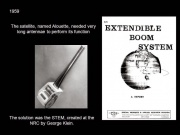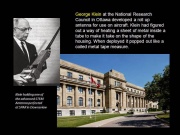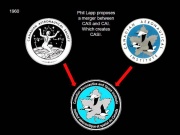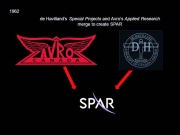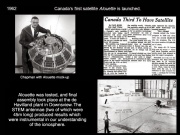100 Years of Aerospace History in Canada: From McCurdy to Hadfield Part 6 by Robert Godwin
From The Space Library
Alouette, the Canadian Aeronautics and Space Institute, SPAR and STEMs
Towards the end of 1959 DeHavilland's profit margins in the Canadian aircraft division were dwindling. The work force in Toronto had been reduced from more than 4000 to just above 2000. The devastating impact of the Arrow cancellation had left A.V. Roe reeling, and its parent company in England, Hawker-Siddeley, blindsided in the aftermath. Big changes were inevitable and on December 18th 1959 Hawker Siddeley purchased DeHavilland. This was a massive takeover involving $37 million and tens of thousands of workers in factories on both sides of the Atlantic.[i]
A few months prior to the DeHavilland takeover, on 25th August 1959 the governments of the United States and Canada had signed an agreement to build and deploy Chapman's top-sounder satellite. The United States would launch it and Canada would design it and operate it.[ii] Later it was agreed that Canada would also build the satellite because of the special needs required by Canadian researchers.
Just a few days after the top-sounder agreement was signed Lapp's CAS showed off a mock-up of their CHARM sounding rocket at the highly visible Institute of Radio Engineers show at the Canadian National Exhibition in Toronto.[iii]
That November an entire page of the Toronto Star featured Lapp alongside the Dean of MIT and the Chair of the National Committee on Space being interviewed about the prospects of space flight.[iv]
Chapman had realized that his team at the National Research Council didn't have the mechanical design skills needed to build the structure of the proposed satellite so he turned to Phil Lapp and the team at DeHavilland. Lapp maintains that this opportunity came about mainly due to the public attention that the CAS had garnered in the media.[v]
Lapp and his team at DeHavilland were given the task of building the main bus and the antennae for the satellite; soon to be known as Alouette. It was clearly understood that to sound the ionosphere in the frequencies of primary interest to the communications and defense industries would require the use of extremely long antennae on the satellite. No such antennae were available at this time. What was needed was something, light, long and rapidly deployable.
Chapman and Lapp both knew immediately that so-called "spin-up" wouldn't work to reliably deploy something many meters long. So Chapman suggested that Lapp take a trip to visit George Klein, at the National Research Council in Ottawa, who had developed a roll up antenna for use on aircraft. Klein had figured out a way of heating a sheet of metal inside a tubular mold to make it emulate the shape. When deployed it popped out like a coiled metal tape measure. Klein had not given any further thought to his invention and had certainly not considered how to make one 22 meters long; which was what would be required for Alouette.
Lapp brought Klein's device back to DeHavilland where the in-house engineers, specifically Ernie Grosskopss, solved the length problem by using magnetic heating and a drawing process to make an antenna of almost any length.[vi] The 22m antenna needed for Alouette was now feasible. This device was given the name Storable Tubular Extendible Member or STEM and would quickly develop into Canada's most successful space product for many years to come.[vii]
STEM would make its first foray into space aboard a Javelin sounding rocket launched from Wallops Island Virginia on June 14th 1961. At 560 miles altitude only one of the two prototype antennae extended successfully, but valuable data was collected. [viii]
While Canada's first satellite gradually developed on the drawing boards, Phil Lapp decided it was time to make his CAS into a more formal organization. He heard that the Canadian Aeronautical Institute (CAI) was considering adding astronautics to its purview. The CAI had formed in 1954 at Downsview to serve the technical side of the aeronautical community.[ix]
As a member of the CAI Lapp decided to approach his Board and offer a merger with the CAS. This offer was quickly accepted and in October 1961 CAS merged with the Canadian Aeronautical Institute to form the Canadian Aeronautics and Space Institute (CASI).[x]
Because of the CF-105 cancellation, one of the facilities now underutilized at the Avro Malton airport location, was the A.V. Roe Applied Research division. Phil Lapp had worked there in the 1950s so when Avro and DeHavilland became one large organization it was suggested that DeHavilland's Special Projects merge with the Applied Research Division of Avro to form Special Projects Applied Research or SPAR.[xi]
Once the merger was authorized by the Board, Lapp immediately set about turning the newly devised STEM antennae into a stand-alone business.
The remarkably versatile STEM would soon evolve in capability and complexity and the team would create BI-STEMs, and non-magnetic STEMs, and it would be used for everything from solar panel deployment mechanisms, to space structural elements, masts, a folding tool holder, and most notably a primitive hand and arm.
On September 29th 1962 Alouette was launched from Vandenberg Air Force Base in California. Aboard the satellite were four STEM antennae two of which, when deployed, reached 45m across. The main chassis for the satellite had been built and tested at the Downsview SPAR facility. The downlink equipment had been made by RCA in Montreal in less than two months and Sinclair Radio of Toronto manufactured most of the telemetry and sounding subsystems.[xii]
Canada's first satellite would be launched using a relatively new booster the Thor Agena B. John Chapman was on hand to watch and noted that the launch was delayed twice, once because an unexpected Southern Pacific fruit train came trundling along the railway tracks a mere 75 meters from the launch pad, and then again because of a faulty abort circuit that suggested that the booster's self-destruct might not work in the case of an emergency. To ensure safety the tiny village of Surf, California, was ordered to be evacuated until the Canadians and their satellite were safely on their way.[xiii]
The launch was successful and Canada became only the third country to put a home-built satellite into orbit (the British had a satellite on orbit but it had been built in the United States.) The staff and management at SPAR were delighted to find out that the STEMs had performed perfectly and Alouette soon began to transmit data to the ground stations.
All through the previous summer DeHavilland's business had continued to grow for the, as yet, untested STEM antenna. The design had been successfully sold to McDonnell Douglas for Gemini. After Alouette, at the very last minute McDonnell decided they wanted to add STEMS to the last couple of Mercury flights. They would be tested immediately on America's third manned orbital flight, piloted by Wally Schirra.
Footnotes
[i] Globe and Mail, Dec 18 1959
[ii] Upper Atmosphere and Space Programs in Canada, Chapman, Lapp, Patterson, Forsyth, Science Secretariat, 1967
[iii] Globe and Mail, Oct 8 1959
[iv] Toronto Star Nov 19 1959
[v] Phil Lapp Memoir pg 131
[vi] Ibid. pg 132
[vii] An Extendible Boom System for Space Vehicles, SPAR, Jan 30 1963
[viii] Thespacelibrary.com
[ix] Globe and Mail Jan 13 1954
[x] Ibid. October 27 1961
[xi] Phil Lapp Memoir Pg 151
[xii] The Alouette Satellite Program - Colin A. Franklin, Chief Electrical Engineer, Alouette I program
[xiii] Spacebound, Theodore Hartz, Irvine Paghis Minister Of Supply and Services, 1982
